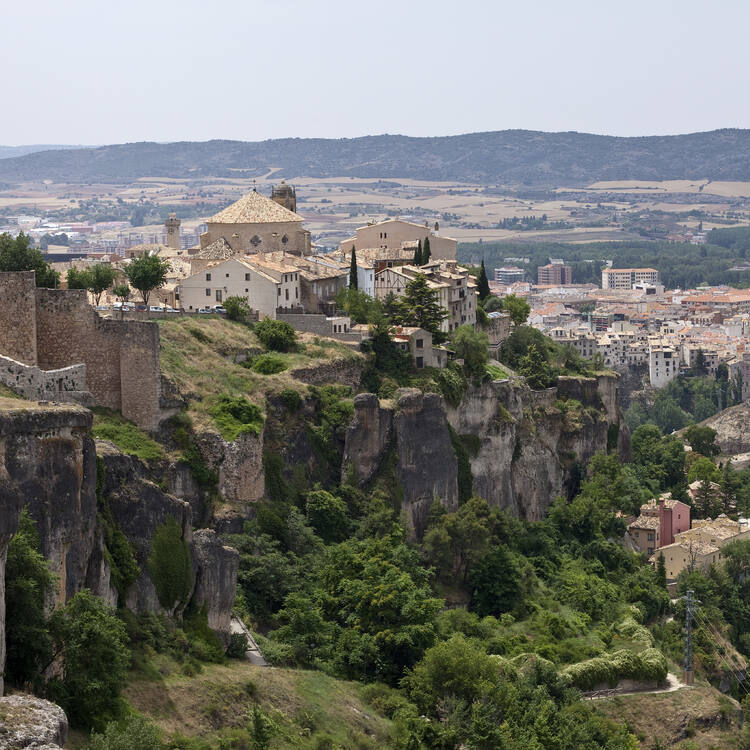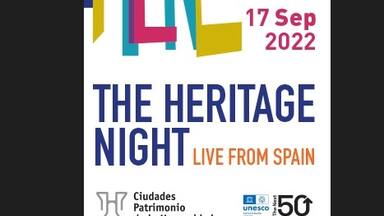Historic Walled Town of Cuenca
Historic Walled Town of Cuenca
Built by the Moors in a defensive position at the heart of the Caliphate of Cordoba, Cuenca is an unusually well-preserved medieval fortified city. Conquered by the Castilians in the 12th century, it became a royal town and bishopric endowed with important buildings, such as Spain's first Gothic cathedral, and the famous casas colgadas (hanging houses), suspended from sheer cliffs overlooking the Huécar river. Taking full advantage of its location, the city towers above the magnificent countryside.
Description is available under license CC-BY-SA IGO 3.0
Ville historique fortifiée de Cuenca
Construite par les Maures sur un site défensif au cœur du califat de Cordoue, Cuenca offre le visage d'une ville fortifiée médiévale remarquablement préservée. Conquise par les Castillans au XIIe siècle, elle devint une ville royale et épiscopale aux nombreux édifices de grande valeur, comme la première cathédrale gothique d'Espagne et les fameuses casas colgadas (maisons suspendues) agrippées aux falaises escarpées surplombant le Huécar. Tirant admirablement parti de sa position, la ville domine fièrement le magnifique paysage qui l'entoure.
Description is available under license CC-BY-SA IGO 3.0
مدينة كوينكا التاريخيّة المحصّنة
بُنيت مدينة كوينكا على يد العرب على موقع دفاعي في وسط خلافة قرطبة وهي واجهة مدينة متوسطية مدعّمة حظيت بأفضل صيانة. احتلّها سكان قشتالة في القرن الثاني عشر وأصبحت مدينةً ملكيّةً وأسقفيّة ذات مبانٍ عديدة عظيمة القيمة مثل الكاتدرائيّة القوطيّة الأولى في اسبانيا والمنازل المعلّقة الشهيرة المتشبثة بالنتوءات المتعرّجة التي تطل على هويكار. تفيد المدينة خير إفادةٍ من موقعها وهي تطل من عل بافتخارعلى محيطها.
source: UNESCO/CPE
Description is available under license CC-BY-SA IGO 3.0
城墙围绕的历史名城昆卡
昆卡城位于科尔多瓦的哈里发统治区中心的重要防御位置,最初由摩尔人建立,由于得到完好保护,现在该古城成为不可多得的中世纪要塞城市的样例。公元12世纪,西班牙卡斯蒂利亚王国收复领土后,昆卡作为皇城和主教富人区,建起了很多建筑,例如西班牙第一座哥特式大教堂和著名的卡萨斯·科尔加达斯(悬空房)。悬空的房子位于峻峭的悬崖之上,俯视瓦拉河。正是由于它所处的优越地理位置,整个城市从周围的乡村中脱颖而出,格外引人注目。
source: UNESCO/CPE
Description is available under license CC-BY-SA IGO 3.0
Укрепленная часть города Куэнка
Основанная маврами как крепость в самом центре Кордовского халифата, Куэнка является редким примером хорошо сохранившегося средневекового укрепленного города. Отвоеванный кастильцами в XII в., он стал королевским городом и центром епархии, богатым важными сооружениями, такими как первый в Испании готический кафедральный собор и знаменитые "касас кольгадас" (висящие дома), которые, действительно, словно подвешены на крутом обрыве над рекой Уэкар. Выгодность расположения города проявляется также в доминировании его крепостных башен над всей живописной округой.
source: UNESCO/CPE
Description is available under license CC-BY-SA IGO 3.0
Ciudad histórica fortificada de Cuenca
Construida con fines defensivos por los musulmanes en el territorio del Califato de Córdoba, Cuenca es una ciudad medieval fortificada en excelente estado de conservación. Una vez conquistada por los castellanos en el siglo XIII, se convirtió en ciudad real y sede episcopal, multiplicándose entonces la construcción de edificios de gran valor, como la primera catedral gótica de España y las famosas casas colgadas, suspendidas en lo alto de la hoz del río Huécar. Excelentemente situada, esta ciudad-fortaleza es el punto culminante del magnífico paisaje rural y natural que la rodea.
source: UNESCO/CPE
Description is available under license CC-BY-SA IGO 3.0
歴史的城壁都市クエンカ
コルドバの中心部にムーア人が防御地点として建設し、よく保存されている中世の要塞都市。12世紀にカスティリアが征服して王都・司教区所在地となり、スペイン初のゴシック伽藍(がらん)や有名な「宙づりの家」などが建設された。source: NFUAJ
Historische ommuurde stad Cuenca
Cuenca werd gebouwd door de Moren in het hart van het kalifaat van Cordoba. Nadat de stad in de 12e eeuw was veroverd door de Castilianen, werd het een koninklijke stad en een bisdom, rijk aan belangrijke gebouwen. Hieronder vallen de eerste gotische kathedraal van Spanje en de beroemde Casas Colgadas (hangende huizen), opgehangen aan steile kliffen met uitzicht op de Huecar rivier. De oude binnenstad van Cuenca is bijzonder omdat het een middeleeuwse vestingstad is waarvan het oorspronkelijk stadsbeeld nog intact is, samen met vele voorbeelden van religieuze en seculiere architectuur uit de 12e tot de 18e eeuw.
Source: unesco.nl
Outstanding Universal Value
Brief synthesis
Cuenca is a municipality located in central Spain, 170 km south-east of Madrid. The historic walled town stretches over 23 hectares, with an important monumental heritage and a consolidated cultural tradition. Built by the Islamic rulers in a defensive position at the outer fringes of the Caliphate of Córdoba, Cuenca is an unusually well-preserved medieval fortified city. The site is dominated by the upper town, developed on the site of Islamic fortress after its conquest by the Castilians in the 12th century. It then became a royal town and bishopric endowed with important buildings.
This is the archetype of the fortress-town, and the part that gives Cuenca its individual character. The “Castillo” quarter is a small suburb just outside the walls, with some remains of the Islamic fortress. Within the upper town there is a wealth of historic religious buildings from the medieval, renaissance, and Baroque periods, notably the 12th century cathedral, built on the site of the former Great Mosque and the first Gothic cathedral in Spain. Taking full advantage of its location, the city towers rise above the magnificent countryside.
No account of the upper town is complete without references to the so-called “Hanging Houses” (casas colgadas). These private houses near the Episcopal Palace were built in the later medieval period on the spectacular steep bluffs overlooking the bend of the Huecar river. Most of them were rebuilt in the 16th century in their present narrow, high form, with two or three rooms on each of three or more floors.
The historic quarter of Cuenca is an outstanding example of the medieval fortress-town. Other examples exist in Spain (Toledo) and in Italy (Urbino, Orvieto) and France (Carcassonne). The special qualities of Cuenca relate to the intact nature of its townscape, as a result of a long period of economic stagnation and social deprivation, and to its dramatic contribution to the natural landscape.
The Old Town of Cuenca has preserved its original townscape remarkably intact along with many excellent examples of religious and secular architecture from the 12th to 18th centuries. It is also exceptional because the walled town blends into and enhances the fine rural and natural landscape in which it is situated.
Criterion (ii): The Old Town of Cuenca is an outstanding example of the medieval fortress town that has preserved its original townscape remarkably intact along with many excellent examples of religious and secular architecture from the 12th to 18th centuries.
Criterion (v): Cuenca is also exceptional because the walled town blends into and enhances the fine rural and natural landscape within which it is situated.
Integrity
The boundaries of the property include the walled town and its suburbs. The walled town of Cuenca shows an integrity of its cultural heritage. The conservation level, restoration works, and the rehabilitation policies have made possible an adequate level of integrity in the historic town. The impact of deterioration processes is controlled. One of the most important threats is the tourism pressure, including affluence of visitors, commercial activities in public spaces and traffic. Other issues are run down edifices, excessive building renovations, and decreasing population numbers due to the lack of facilities and insufficient mobility.
Some restoration works have been carried out very respectfully and have maintained the integrity of the monuments. All reconstructions in historic buildings are made on the basis of complete and detailed documentation. This has been done thanks to the work of the different administrations (Town Hall of Cuenca and the Department of Culture of the Autonomous Community).
Authenticity
The importance of the upper town lies not so much in its individual buildings, though many of these are of outstanding architectural and artistic quality, as in the townscape that they create when looked at as a group, on the fortified site dominating the river valleys. This feature gives Cuenca its special character and quality. In the light of the fact that the significance of Cuenca lies in its overall townscape as an historic ensemble, it may fairly be asserted that the authenticity is very high. The protection arrangements and the conservation strategies are considered sufficiently effective to respect the authenticity of the historic walled town of Cuenca.
Protection and management requirements
The historic zone of Cuenca, which was declared a “Picturesque Site” in 1963, is designated as a Historic Ensemble under the provisions of Law No 16/1985 on the Spanish Historic Heritage. The Royal Board of the City of Cuenca was created to operate as a permanent collegiate body promoting and coordinating all action, so the current management system is sufficiently effective. The legal framework, which encompasses Cuenca´s heritage management, consists of a wide array of regulations issued by different administrative levels. The Spanish administration provides a state law which defines the main protection figures, addresses the planification of historic cities and other issues regarding international conventions linked with heritage protection. The regulations promulgated by the Government of Castilla La Mancha deal with specific protection levels as well as territorial and urban planning activity. The historic town of Cuenca is included in the Register of Cultural Interest Sites with the category of Historic Site. Furthermore, there is a General Urban Zoning Scheme, and a Special Scheme for the Planning and Improvement Plan and Protection of Cuenca’s Old Quarter and its Hoces (Special Plan). Changes need to be made in respect of urban planning regimes, and the specific planning and management bodies taking part in the relevant processes through the Royal Board Consortium.
Although great strides have been made, the use of traditional construction materials and construction sizes will be further improved due to the continued valorisation of the urban landscape. In line with the recommendations of the Special Plan, it is also necessary to regulate run-down buildings, excessive building renovations, and the decrease of population due to lack of facilities and insufficient mobility. The old walled town of Cuenca needs measures to improve urban regulation, rehabilitation programmes, public transportation alternatives, and pedestrian accessibility. Control has increased through the maintenance of pre-existing vernacular structures and improving their residential and commercial use.

 View photos from OUR PLACE the World Heritage collection
View photos from OUR PLACE the World Heritage collection

